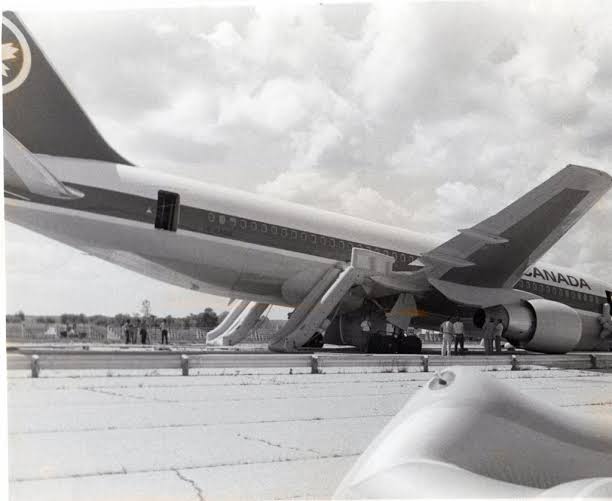Many years ago a (TACA I think) pilot dead sticked a 737 onto a levee in New Orleans with no damage and no injuries. He began flying in gliders at 16. It"s a very informative read.
Yeah, but he also set it down on dry land.
Follow along with the video below to see how to install our site as a web app on your home screen.
Note: This feature may not be available in some browsers.
Ad: This forum contains affiliate links to products on Amazon and eBay. More information in Terms and rules
Many years ago a (TACA I think) pilot dead sticked a 737 onto a levee in New Orleans with no damage and no injuries. He began flying in gliders at 16. It"s a very informative read.
There's nothing like starting out in gliders at 14 or younger to produce a superb stick and rudder pilot. Some of the 13 and 14 year old line workers I gave lessons to back in the 80s have become military and airline pilots. The other day I heard about one who's a triple7 captain now and spent 8 years in F18s along the way.Many years ago a (TACA I think) pilot dead sticked a 737 onto a levee in New Orleans with no damage and no injuries. He began flying in gliders at 16. It"s a very informative read.
Sully was skillful, lucky, and an experienced glider pilot, as well as operating in daylight. All the "best case" circumstances lined up that day to turn a potential disaster into a miracle. Not to be expected as a norm. He touched down in relatively smooth water at just the right angle of attack to turn the fancases of his engines into surfboards rather than water scoops, and with his sink rate briefly at its lowest possible value. The airline equivalent of flying a battle damaged fighter through an OK (Underline) pass to a perfect 3-wire trap on a trick-or-treat approach with hung ordnance on the racks.
And made it look like a piece of cake, an outcome that was by no means guaranteed.What?
And I thought that all Sully did was just ditch the plane into the Hudson river.
The TACA pilot was routed through a severe thunder storm (the south Louisiana type) on approach to MSY (Moisant) and not allowed to deviate. Although ignition plugs were on, the water ingested flamed out both engines at fairly low altitude. He had prepared the the cabin crew & passengers for a water landing as he could see the canal through the storm and headed for it. Just before touch down, he saw the levee and adjusted, extended L/G. This levee is near the Michoud plant and basically swamp land 45 years ago. The airline two weeks flew it out after removing seats and heavy stuff. Flown out by the airline check pilot and chief mechanic.
And made it look like a piece of cake, an outcome that was by no means guaranteed.

Saw the program on this, he lost both engines in a storm and side slipped it to perfectly land on the grass levee. I don't think side slipping is a required learn these days.Many years ago a (TACA I think) pilot dead sticked a 737 onto a levee in New Orleans with no damage and no injuries. He began flying in gliders at 16. It"s a very informative read.
Saw the program on this, he lost both engines in a storm and side slipped it to perfectly land on the grass levee. I don't think side slipping is a required learn these days.
A few days later they lightened the plane and flew it off.
Norman
(FAA think) "If you've got flaps who needs side slips?"I don't think side slipping is a required learn these days.
I love that kind of talk!(FAA think) "If you've got flaps who needs side slips?"
BZZZT, WRONG!! It's all about mastery of your aircraft. Sooner or later you're going to have to make that gusty crosswind landing at the limits of your plane's crosswind component.

They're the guys who make the scary look easy.
That's exactly it. This is where pilots earn their keep. The routine stuff is the easy part. Yeah, there's skill required to fly a big jet, but the real money is earned when stuff goes wrong. Human Factors in aviation is a huge investment with systems and processes in place applied to almost every aspect of operations to minimise risk, but stuff goes wrong because we're human and we make mistakes, so when these guys are put into a threatening situation, it takes every ounce of their training and decision making to get them to make the best outcome, which is to minimise the risk to those on board.
Except where the flight manual says to avoid them (C-172). I've done it, but would never have taught it as the aircraft can have some erratic handling.(FAA think) "If you've got flaps who needs side slips?"
BZZZT, WRONG!! It's all about mastery of your aircraft. Sooner or later you're going to have to make that gusty crosswind landing at the limits of your plane's crosswind component.
AFAIK, C172 prohibition on slips is only with 20°+ flaps. At least that was the case on the ones I flew. To be on the safe side, I never slipped with more than 10°, and I never experienced any erratic handling. Most of the ones I flew were 1970s vintage and earlier.Except where the flight manual says to avoid them (C-172). I've done it, but would never have taught it as the aircraft can have some erratic handling.